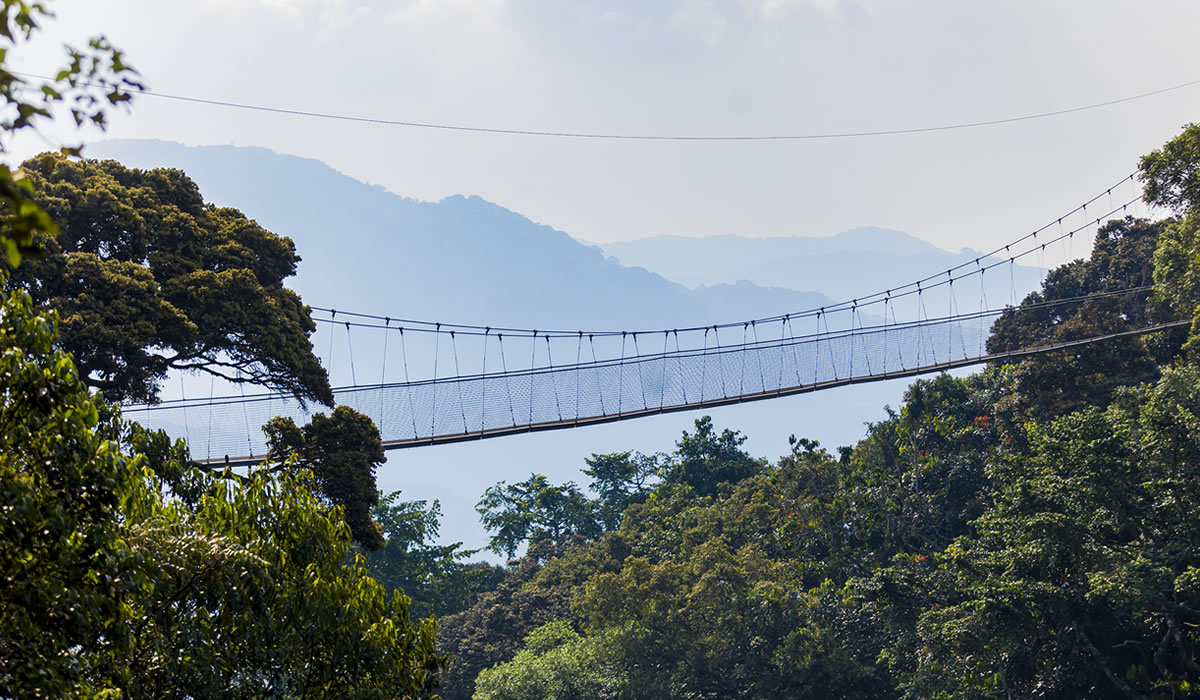Nyungwe Forest National Park is one of the most remarkable natural treasures in East Africa. Located in the southwestern part of Rwanda near the border with Burundi and the Democratic Republic of Congo, the park covers more than 1,000 square kilometers of montane rainforest, bamboo thickets, grasslands, swamps, and bogs. It is not only one of the largest remaining tracts of pristine tropical rainforest in Africa but also a key biodiversity hotspot that attracts researchers, conservationists, and tourists from all over the world. Nyungwe is often described as a place of wonder because it combines breathtaking natural beauty with incredible wildlife encounters, making it a must-visit destination for anyone exploring Rwanda.

Nyungwe Forest is believed to be one of the oldest rainforests in Africa, with an estimated age of over 25 million years. Its ancient ecosystem has provided a sanctuary for rare plants and animals throughout history, even surviving the Ice Age while many other forests disappeared. Today, it remains a critical water catchment area in the region, feeding two of the world’s great rivers: the Nile and the Congo. This role as a watershed has earned Nyungwe immense ecological importance, as it contributes to the livelihoods of millions of people who depend on these river systems. For Rwanda, the park is not just a natural heritage site but also a pillar of eco-tourism, drawing visitors interested in nature, adventure, and cultural experiences.
One of the most fascinating aspects of Nyungwe Forest National Park is its extraordinary biodiversity. The park is home to more than 1,068 plant species, including over 200 types of trees and numerous medicinal plants that local communities have used for generations. Among its most unique plant species are giant lobelias and orchids that add striking color to the forest. In addition, Nyungwe supports an incredible range of fauna, including more than 85 mammal species, 310 bird species, 32 amphibians, and 38 reptiles. Many of these animals are endemic to the Albertine Rift, a region of high endemism that makes Nyungwe an internationally recognized biodiversity hotspot.
Primates are among the biggest attractions for tourists visiting Nyungwe. The park is home to 13 primate species, making it one of the richest primate habitats in East Africa. Chimpanzees are the most famous residents, and chimpanzee trekking is one of the highlights of a visit here. Visitors set out early in the morning with experienced trackers to follow chimpanzees as they forage, groom, and play in the trees. Observing these intelligent primates in their natural environment is both thrilling and humbling. In addition to chimpanzees, Nyungwe is also home to large groups of colobus monkeys, particularly the Angolan colobus, which can be seen in troops of up to 400 individuals. Other primates include the L’Hoest’s monkey, red-tailed monkey, grey-cheeked mangabey, vervet monkey, olive baboon, and the golden monkey, making primate watching an unforgettable experience.
Birdwatchers will find Nyungwe Forest to be a paradise, as it hosts some of the most sought-after species in Africa. The park is classified as an Important Bird Area (IBA) due to its incredible avifauna. With 310 bird species, including 27 Albertine Rift endemics, Nyungwe is a premier destination for ornithology enthusiasts. Iconic species include the Ruwenzori turaco, Grauer’s swamp warbler, regal sunbird, and the red-collared mountain babbler. The diversity of birdlife here is unmatched in Rwanda and ranks among the highest in Africa, ensuring that birding tours are always rewarding.
For those who love hiking and nature walks, Nyungwe Forest offers an extensive network of well-maintained trails that stretch over 130 kilometers. These trails vary in length and difficulty, catering to both casual walkers and experienced hikers. The Igishigishigi Trail is one of the most popular, partly because it leads to the famous canopy walkway. This suspension bridge, which hangs 60 meters above the forest floor and extends 160 meters long, offers visitors a rare chance to view the forest from above the treetops. Walking across the canopy bridge provides breathtaking panoramic views of the forest and an opportunity to spot birds and monkeys at eye level. Other trails such as the Congo Nile Divide Trail, the Isumo Waterfall Trail, and the Kamiranzovu Marsh Trail offer diverse experiences ranging from scenic waterfalls to encounters with rare plant species.
Cultural experiences also form part of a visit to Nyungwe Forest National Park. Rwanda has a rich cultural heritage, and local communities around the park engage in traditional activities that showcase their way of life. Tourists can participate in cultural performances, taste local food, and learn about traditional medicine, farming, and crafts. These community-based tourism initiatives provide an added dimension to a safari in Nyungwe, while also ensuring that local people benefit directly from conservation and tourism. This symbiotic relationship helps foster support for the protection of the forest.
The park also plays a central role in Rwanda’s conservation strategy. Managed by the Rwanda Development Board (RDB) in partnership with conservation organizations such as African Parks, Nyungwe has benefited from strong protection and sustainable tourism development. Anti-poaching patrols, reforestation projects, and community outreach programs have significantly reduced threats to the forest and its wildlife. Rwanda’s government has positioned the park as part of its vision for eco-tourism, alongside other attractions such as Volcanoes National Park and Akagera National Park, creating a diverse tourism circuit that appeals to global travelers.
Accessibility to Nyungwe has greatly improved over the years, making it easier for visitors to include the park in their Rwanda itineraries. The park is about a five to six hour drive from Kigali, Rwanda’s capital, via well-paved roads that pass through scenic landscapes and vibrant towns. Alternatively, domestic flights can be arranged to Kamembe Airport near Cyangugu, which is only a short drive from the park’s entrance. Once inside the park, there are several accommodation options ranging from luxury lodges to mid-range hotels and budget guesthouses. Nyungwe Forest Lodge, One&Only Nyungwe House, and Gisakura Guest House are among the most popular choices, providing comfortable stays that complement the natural beauty of the forest.
Tourism activities in Nyungwe are designed to be sustainable and environmentally friendly. Visitors are encouraged to follow park guidelines to minimize their impact on the fragile ecosystem. Group sizes for chimpanzee trekking are kept small to reduce disturbance, and strict rules are enforced to protect both wildlife and tourists. These conservation-focused practices ensure that future generations will continue to enjoy the wonders of Nyungwe Forest.
Beyond its ecological and touristic value, Nyungwe Forest National Park also holds great scientific importance. Researchers frequently conduct studies in the park, focusing on primate behavior, plant diversity, bird ecology, and climate change impacts. These studies not only advance scientific knowledge but also inform conservation strategies that benefit the park and similar ecosystems worldwide. By supporting conservation through tourism, visitors contribute indirectly to this body of knowledge and to the protection of biodiversity.
A visit to Nyungwe Forest National Park can be combined with other destinations in Rwanda for a well-rounded travel experience. Many travelers opt to start in Kigali, then head to Nyungwe for primates and hiking, before continuing to Volcanoes National Park for gorilla trekking and finally Akagera National Park for classic savanna safaris. This combination highlights Rwanda’s extraordinary diversity within a relatively small geographical area.
For those planning a trip, the best time to visit Nyungwe is during the dry seasons, from June to September and December to February, when hiking trails are more manageable and wildlife sightings are more predictable. However, because Nyungwe is a rainforest, visitors should always be prepared for sudden showers regardless of the season. The wet season from March to May and October to November brings lush vegetation and is particularly good for birding, although trekking conditions may be more challenging.
Nyungwe Forest National Park is much more than a travel destination, it is a sanctuary of life and a symbol of Rwanda’s commitment to conservation. Its ancient forest, diverse wildlife, and vibrant cultural connections create a unique blend of natural and human heritage. Whether you are a primate enthusiast, a hiker, a birdwatcher, or a traveler simply looking for a tranquil escape, Nyungwe offers an experience that is both enriching and unforgettable. As Rwanda continues to establish itself as a top African safari destination, Nyungwe stands out as a crown jewel that deserves a place on every traveler’s itinerary.
In conclusion, Nyungwe Forest National Park represents one of the finest examples of how nature and tourism can work hand in hand. Its rich biodiversity, iconic primate encounters, canopy walkway adventures, and cultural experiences make it a world-class destination. For travelers searching for a unique and eco-friendly safari in Rwanda, Nyungwe Forest remains one of the most rewarding places to explore. By visiting, you not only experience the wonders of an ancient rainforest but also contribute to the ongoing efforts to preserve one of Africa’s most treasured natural landscapes.
